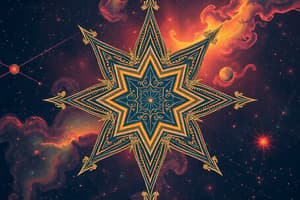Podcast
Questions and Answers
What is a nebula?
What is a nebula?
A cloud of gas and dust where stars are formed.
What stage does a protostar become when fusion begins?
What stage does a protostar become when fusion begins?
- Red giant
- White dwarf
- Main sequence star (correct)
- Black dwarf
A white dwarf is the end stage of a large star.
A white dwarf is the end stage of a large star.
False (B)
What happens to a white dwarf over time?
What happens to a white dwarf over time?
The process of hydrogen nuclei undergoing fusion produces _____ nuclei.
The process of hydrogen nuclei undergoing fusion produces _____ nuclei.
What determines if a star ends up as a black hole or a neutron star?
What determines if a star ends up as a black hole or a neutron star?
What is a red supergiant?
What is a red supergiant?
Match the following terms with their definitions:
Match the following terms with their definitions:
When a white dwarf becomes too cold, it turns into a _____ dwarf.
When a white dwarf becomes too cold, it turns into a _____ dwarf.
Flashcards are hidden until you start studying
Study Notes
Morning Prayer and Activities
- Begins with a prayer thanking for protection and guidance in learning.
- Emphasizes inspiration by the Holy Spirit during the lesson.
Attendance Check
- A brief process to acknowledge student presence.
Mystery Box Game
- Teams are created to answer questions based on a selected letter.
- Players decide to either keep or give the box, which contains uncertain points that can be beneficial or detrimental.
Life Cycle of a Star
- Stars undergo a definitive life cycle, starting as a nebula.
- The Sun is categorized as a main sequence star, indicating a stable phase in its life cycle.
Formation of Stars
- Stars form from massive clouds of gas and dust, known as nebulae, which unite due to gravity.
- Gravity increases temperature and density, leading to the formation of a protostar.
Protostar Phase
- A protostar is the initial phase where the core isn’t hot enough for fusion but begins to glow.
- Eventually stabilizes and evolves into a main sequence star.
Main Sequence Stars
- These stars maintain a stable state for billions of years, with fusion in the core converting hydrogen to helium.
- Outward pressure from fusion balances gravitational forces, sustaining the star's structure.
Life Stages of Smaller Stars
- After its main sequence phase, a smaller star expands into a red giant, then ejects layers to become a white dwarf.
- Finally, it cools down and becomes a black dwarf.
Stellar Nebula
- Nebulas contain hydrogen gas essential for star formation.
- Gravity draws hydrogen clumps together, transitioning them into protostars.
White Dwarf Characteristics
- Formed after a star has ceased fusion, remaining hot initially but gradually cooling over time.
- Their radiation shifts from high color temperature to a redder hue as they cool.
Black Dwarf Description
- A theoretical stage where a white dwarf cools completely and can no longer produce significant heat or light.
- Formation time of black dwarfs exceeds the universe's current age, leading to uncertainty about their existence.
Large Stars and Their Evolution
- Red supergiants are significantly larger than red giants and exhibit greater brightness.
- They can contract under specific conditions, fusing elements at varying rates and eventually transforming into blue supergiants.
Fate of Massive Stars
- The destiny of massive stars—either becoming a neutron star or a black hole—is dictated solely by their mass following supernova events.
- A remnant mass under 2.16 solar masses collapses into a neutron star, while greater masses lead to black hole formation.
Studying That Suits You
Use AI to generate personalized quizzes and flashcards to suit your learning preferences.




